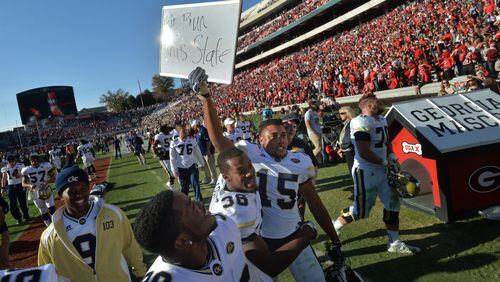For Georgia Tech’s defense, the 2016 season turned after the disastrous North Carolina game, when the Tar Heels demolished the Yellow Jackets in a 48-20 thrashing. After one of the poorest defensive performances in school history, Tech defensive coordinator Ted Roof cut down the playbook to ensure his unit had calls and concepts that it was confident of executing.
“It was real basic stuff that we learned Day 1,” former Tech defensive end Rod Rook-Chungong said.
After the change, the Jackets played their best defense of the season as they defeated Virginia Tech, Virginia, Georgia and Kentucky to finish 9-4. This spring, with eight starters back, the temptation might have been to build on that momentum by adding more to the playbook. Instead, Roof has dialed back and kept it simple. The hope is that more will be less.
“Because I want guys to know the in-depth details of the defense, not just the surface things,” Roof said.
Roof said he was prompted by the lessons of the final four games of the season. The statistical differences are stark. The Jackets gave up 6.7 yards per play in the first six games against power-conference teams and 5.1 in the final four.
Power-conference opponents completed 65.5 percent of their passes for 8.4 yards per attempt through the North Carolina game. The numbers dropped to 59.4 percent and 5.1 yards per attempt in the final four games.
Rook-Chungong attributed it to the simplification of the defense. Roof sought the input of players about what they were comfortable and confident running and stuck to that, he said. Players didn’t have to think through assignments.
“It helped a lot,” said Rook-Chungong, now a sales associate for Nabisco.
Roof has been devoting more attention to fewer calls and concepts, giving players more practice repetitions running the same schemes. The learning is not wider, but deeper.
“So as coaches, we’ve got to make sure we’re coaching the details day in, day out,” Roof said. “Not just what has happened, but what can happen. And give them answers to how we’re handling that or handling that. And try to put them in situations where they can see it and rep it, and that’s what we’re trying to do, is rep some of the same calls over and over against a bunch of different things.”
Players have noticed the difference in spring practice, which concludes Friday night with the spring game at Bobby Dodd Stadium.
“It’s a lot different than what it was last year,” linebacker Brant Mitchell said. “I think guys are soaking in the information a lot better. I think last year was a lot faster and a lot more at us, but this year, I think it’s helping giving us a base to start with. I think that’s helping, especially the younger guys, the guys that are just coming in, the guys that are trying to get some playing time.”
One objective that Roof has often brought up is for players not just to know the concepts and calls that the defense uses, but to understand how they work, where they are strong and where they’re vulnerable.
“So when I first got here I think we went over a lot of material,” said Shaun Kagawa, a senior safety. “We put in a lot of blitzes, we did a lot of concepts scheme-wise. I think by scaling it back, we’re able to concentrate more on our weaknesses, in a sense, and our strengths, so when we get to a season, we’ll be able to see what those strengths were when we look back to the spring.”
One potential added benefit — Tech’s signing class has multiple members that have the potential to contribute right away, including linebacker Bruce Jordan-Swilling and safety Kaleb Oliver. The easier their transition is in preseason camp, the more likely it is they can make an impact next season on defense.
“It definitely is easier to speed it up than it is to clean it up,” cornerbacks coach Joe Speed said. “So we want to start off slow and make sure that the guys get that good fundamental base.”
It hardly guarantees the Jackets will be defensive terrors. They have to find trustworthy players at defensive tackle. The vulnerability of playing fewer calls is that opponents have less to prepare for and decipher. And it’s worth noting that Tech didn’t finish its schedule against offensive powerhouses. By measure of offensive yards per play, Virginia Tech ranked 68th (tie), Virginia 119th, Georgia 86th (tie) and Kentucky 32nd.
The stronger offensive teams, such as North Carolina, Miami and Pittsburgh, were at the front of the schedule.
Still, if the Jackets can carry forward the defense that helped produce a four-game winning streak and made a stream of big plays in that span — defensive tackle Patrick Gamble had 4.5 sacks and the defense had seven interceptions — it would seem worth trying.
It has Rook-Chungong’s support.
“You have all that experience and the speed like they have, they should be successful,” he said.







